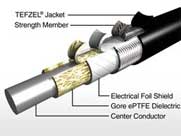Lightweight 0.190" spaceflight microwave cable assemblies have been introduced that weigh 20 percent less than the company's traditional 0.190" cable assemblies. The new cables are qualified to operate up to 18 GHz over a -100° to +125°C temperature range and are designed to meet the rigorous requirements of the space environment.
The spaceflight microwave cable assemblies offer an extremely low insertion loss by virtue of their unique cable design that exploits the low dielectric constant, low loss tangent and consistency of expanded polytetrafluoroethylene (ePTFE) dielectric material. Their construction uses radiation resistant materials, including TEFZEL® jacket material, to ensure that the cables remain structurally sound in radiation environments up to 100 Mrad.

Cable Construction
The basic cable design is shown in Figure 1. The low dielectric constant of the ePTFE dielectric core (  r
r  1.4) allows the use of center conductors with nearly twice the surface area per unit length as those used in solid PTFE cables of comparable diameter, while still maintaining a 50 Ω characteristic impedance. This technique provides a significant decrease in assembly insertion loss and enables higher transmission power. The superior loss tangent of ePTFE further reduces the assemblies' insertion loss, particularly as the frequency of operation increases.
1.4) allows the use of center conductors with nearly twice the surface area per unit length as those used in solid PTFE cables of comparable diameter, while still maintaining a 50 Ω characteristic impedance. This technique provides a significant decrease in assembly insertion loss and enables higher transmission power. The superior loss tangent of ePTFE further reduces the assemblies' insertion loss, particularly as the frequency of operation increases.
The conforming nature of the ePTFE dielectric allows the use of an electrical shield with 100 percent coverage. The shield consists of a helically wrapped and overlapped silver-plated copper foil. The overlaps are in intimate contact with each other and with the ePTFE dielectric. The result is minimized signal leakage from the cable and less resistance to signal flow on its inside surface, both of which further reduce insertion loss. Additionally, a braided mechanical shield is placed over the electrical shield to increase the cable's crush resistance, torque resistance and connector pull strength.
The outer jacket on the spaceflight cable is TEFZEL material from E.I. duPont deNemours and Co. This material offers superior radiation resistance without compromising flexibility.
Connector types used on the new spaceflight cable assemblies include SMA straight, swept right angle and elbowed right angle versions, and straight and swept right angle TNCA connectors. All are usable to 18 GHz.
Performance and Reliability
Every microwave cable assembly is 100 percent tested, x-rayed, inspected and certified to meet the requirements contained in the applicable specifications, whether stated in the Spaceflight Microwave Cable Assemblies catalog or in pre-approved customer contracts. The manufacturing facility used is ISO 9001/ 14001 certified.
The flexible microwave cable assemblies exhibit improved performance and reliability in phase sensitive system environments by offering excellent phase vs. temperature and phase vs. flexure performance. The TEFZEL jacket material ensures that the cable remains structurally sound in high radiation environments, and the assemblies are designed to meet 90 dB/ft effective shielding (exclusive of connectors) per the MIL-STD 1344, method 3008, mode-stirred chamber (DC to 18 GHz) or sniffer-probe method over 18 GHz. All this results in lower program costs and reduced risk for the user.
W.L. Gore & Associates Inc., Elkton, MD (800) 445-4673 or (302) 292-5100, www.gore.com/electronics. Circle No. 302
